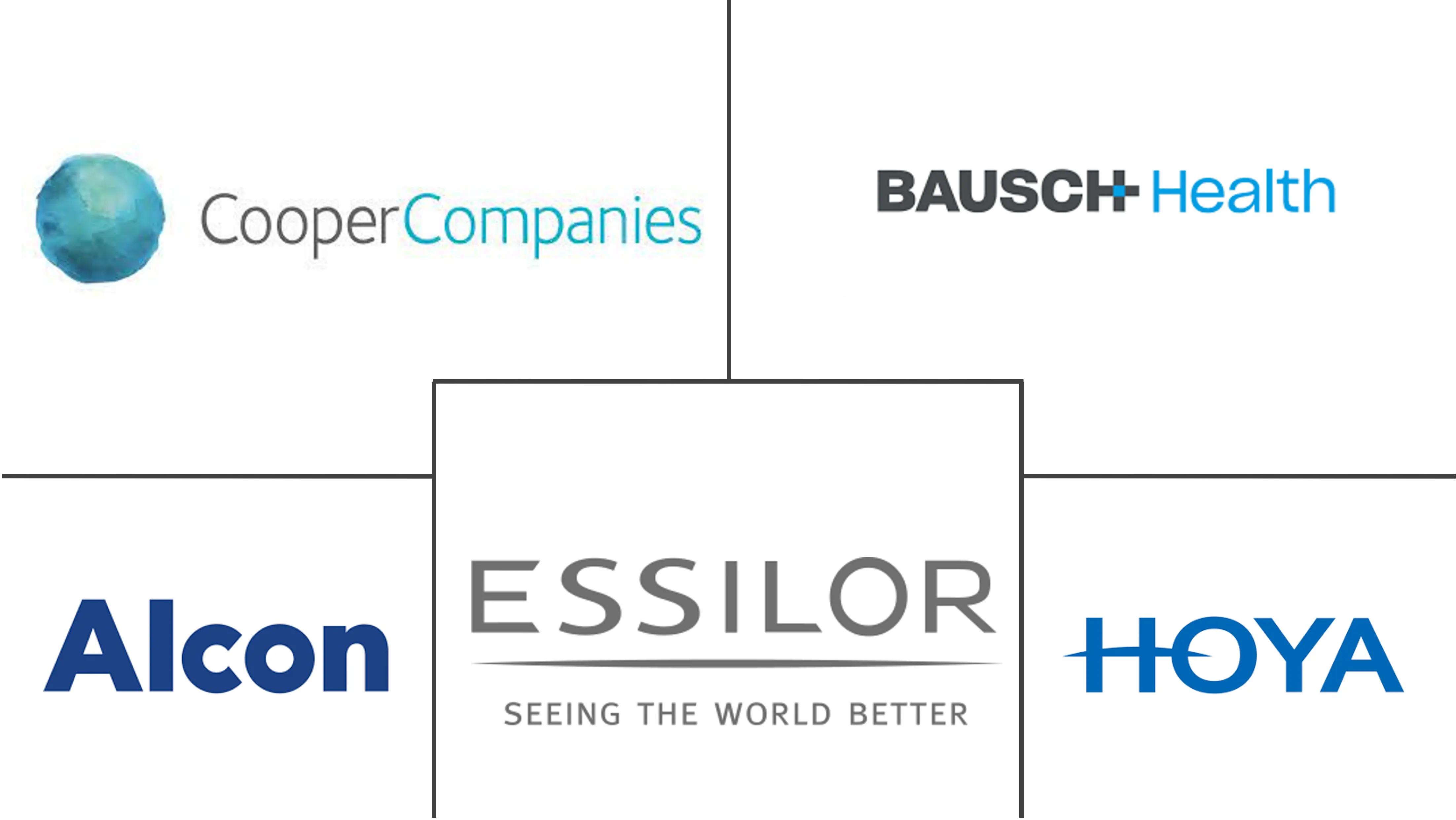Contact Lenses Market Size and Share
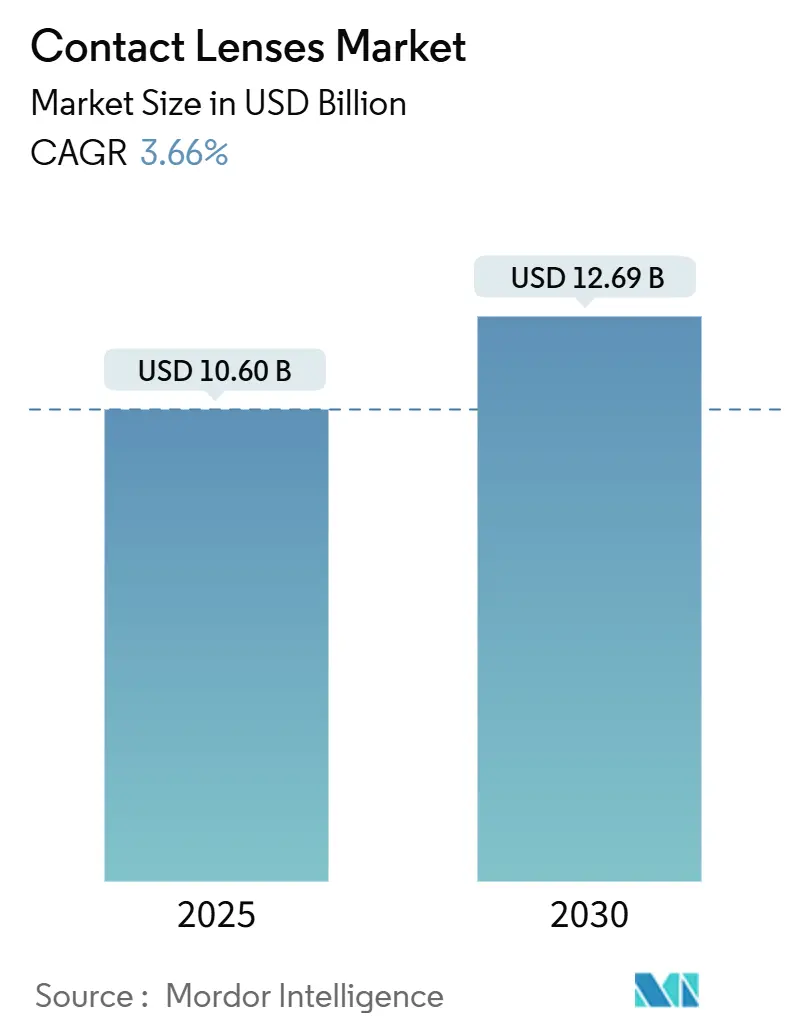
Contact Lenses Market Analysis by Mordor Intelligence
The Contact Lenses Market size is estimated at USD 10.60 billion in 2025, and is expected to reach USD 12.69 billion by 2030, at a CAGR of 3.66% during the forecast period (2025-2030).
This steady expansion springs from premium material adoption, therapeutic lens launches, and the ongoing pivot to e-commerce rather than from a rising wearer base. Myopia’s rapid spread, especially among urban Asian youth, keeps demand resilient, while convenient daily disposables reinforce recurring revenue. Silicone-hydrogel remains the cornerstone material because it cuts hypoxia risk and underpins advanced designs such as smart sensors and drug-eluting lenses. On the commercial side, omnichannel strategies protect incumbents as online specialists chip away at brick-and-mortar traffic, and sustainability mandates spur R&D aimed at recyclable blisters and PFAS-free chemistries.
Key Report Takeaways
- By material, silicone-hydrogel lenses commanded 55.59% of the contact lens market share in 2024; the same segment is projected to post a 4.35% CAGR through 2030.
- By design, spherical lenses led with 42.34% revenue share in 2024, whereas toric lenses are forecast to clock the fastest 4.67% CAGR over 2025-2030.
- By usability, daily disposables accounted for 48.93% of the contact lens market size in 2024 and are advancing at a 5.01% CAGR during the outlook period.
- By application, vision-correction lenses retained 59.45% share of the 2024 base, while myopia-control products are expanding at a 5.37% CAGR to 2030.
- By distribution channel, retail optical stores held 46.67% of the contact lens market revenues in 2024, although online and e-commerce outlets are growing faster at a 5.76% CAGR.
Global Contact Lenses Market Trends and Insights
Driver Impact Analysis
| Driver | (~) % Impact on CAGR Forecast | Geographic Relevance | Impact Timeline |
|---|---|---|---|
| Rising prevalence of myopia among youth | +1.8% | Global, with highest impact in Asia-Pacific | Long term (≥ 4 years) |
| Rapid adoption of daily disposable soft lenses | +0.9% | North America & Europe leading, expanding to APAC | Medium term (2-4 years) |
| Technological breakthroughs in silicone-hydrogel & smart lenses | +0.6% | Global, with innovation centers in US, Europe, Japan | Long term (≥ 4 years) |
| Expansion of e-commerce & D2C distribution | +0.4% | Global, accelerated in post-pandemic markets | Short term (≤ 2 years) |
| Surge in cosmetic & colored lens demand among Gen-Z in Asia | +0.3% | Asia-Pacific core, spill-over to other regions | Medium term (2-4 years) |
| Source: Mordor Intelligence | |||
Rising Prevalence of Myopia Among Youth
Global myopia prevalence among children and adolescents is forecast to reach 39.80% by 2050, translating into more than 740 million affected individuals[1]Source: British Journal of Ophthalmology, “Global Prevalence of Myopia,” bjo.bmj.com. East Asian cities record the sharpest increments, with screen-time escalation during COVID-19 restrictions accelerating axial length growth. As myopia commonly begins in childhood and progresses through teenage years, demand stabilizes for corrective wear across the contact lens market, while dual-focus and peripheral defocus lenses emerge to slow progression. One Chinese trial showed dual-focus soft lenses limiting axial elongation by 0.10 mm versus spectacles over one year[2]Source: BMC Ophthalmology, “Dual-Focus Soft Lenses Slow Axial Length Growth,” bmcophthalmol.biomedcentral.com. This therapeutic edge shifts procurement from commodity correction toward premium prophylactic devices.
Rapid Adoption of Daily Disposable Soft Lenses
Daily disposables jumped from 17.1% of soft lens fits in 2000 to 46.7% in 2023, mirroring heightened hygiene awareness and convenience priorities. Uptake correlates with GDP per-capita, so penetration is deepest in the United States, Canada, and Western Europe. Younger adults prefer single-use wear that removes cleaning chores, while practitioners welcome the lower infection profile. Silicone-hydrogel disposables blend high oxygen flux with single-use packaging, although price sensitivity restrains emerging-market adoption, especially in cost-pressured segments of the contact lenses market.
Technological Breakthroughs in Silicone-Hydrogel & Smart Lenses
Silicone-hydrogel represents 76% of global soft lens fits [coopervision.com], owing to breathable matrices that combat corneal hypoxia. Research extends well beyond optics: Nanyang Technological University engineers devised tear-powered micro-batteries thin enough for in-lens integration; other teams print polyvinyl-alcohol releasing scaffolds for dry-eye relief. These advances recast lenses as diagnostic and drug-delivery platforms, raising entry thresholds for firms lacking deep materials science benches.
Expansion of E-commerce & D2C Distribution
Lens e-tailers scale fast as prescription verification systems mature and subscription deliveries amplify repeat sales. COVID-19 lockdowns nudged digital adoption, and daily disposables align naturally with automated replenishment. Still, regulatory checks—especially in the United States, where the Contact Lens Rule mandates valid scripts—temper unfettered growth, fortifying omnichannel incumbents that pair online portals with practitioner network. The digital shift is now a defining structural change within the modern contact lenses market.
Restraint Impact Analysis
| Driver | (~) % Impact on CAGR Forecast | Geographic Relevance | Impact Timeline |
|---|---|---|---|
| Contact-lens related dry-eye & wearer drop-outs | -0.6% | Global, with higher impact in dry climates | Medium term (2-4 years) |
| Stringent FDA / CE regulatory approvals | -0.5% | North America & Europe primarily | Long term (≥ 4 years) |
| Sustainability backlash against single-use plastics | -0.4% | Europe & North America leading, expanding globally | Medium term (2-4 years) |
| Growing uptake of low-cost refractive surgeries (SMILE) in Asia | -0.3% | Asia-Pacific core, particularly China, South Korea | Short term (≤ 2 years) |
| Source: Mordor Intelligence | |||
Contact-Lens Related Dry-Eye & Wearer Drop-Outs
An estimated 30%–50% of the world’s 140 million lens wearers experience dry-eye symptoms that often culminate in discontinuation. Tear instability and surface desiccation degrade comfort, especially in extended-wear and monthly modalities. Manufacturers respond with water-gradient surfaces and self-lubricating coatings; Delefilcon A dailies significantly eased symptoms in one multi-center study. Microfluidic channels that pump tears across the cornea remain experimental but illustrate the race toward physiological compatibility.
Stringent FDA / CE Regulatory Approvals
As lenses morph into drug reservoirs and electronic sensors, they enter uncharted regulatory categories. The United States Food & Drug Administration recently issued Complete Response Letters for several ocular therapeutics, signaling intensified evidence demands. In Europe, MDR rules toughen biocompatibility dossiers and post-market surveillance obligations, elongating launch timetables and inflating compliance budgets. Smaller innovators face capital hurdles unless they partner with seasoned market holders.
Segment Analysis
Soft Contact Lenses Segment in Contact Lenses Market
The soft contact lenses segment continues to dominate the global contact lenses market, commanding approximately 64% of the contact lenses market share in 2024. This significant market position is attributed to the numerous advantages these lenses offer over other product types, including superior comfort, easier adaptation for new users, and better oxygen permeability to the cornea. The segment's growth is further bolstered by technological advancements in silicone hydrogel materials, which provide enhanced breathability and moisture retention. Major market players like Johnson & Johnson Vision and Alcon have strengthened this segment through their innovative product offerings, particularly in daily disposable and monthly replacement categories. The segment is also experiencing the fastest growth rate in the market, driven by increasing consumer preference for comfortable vision correction solutions and the rising adoption of contact lenses for both medical and cosmetic purposes.
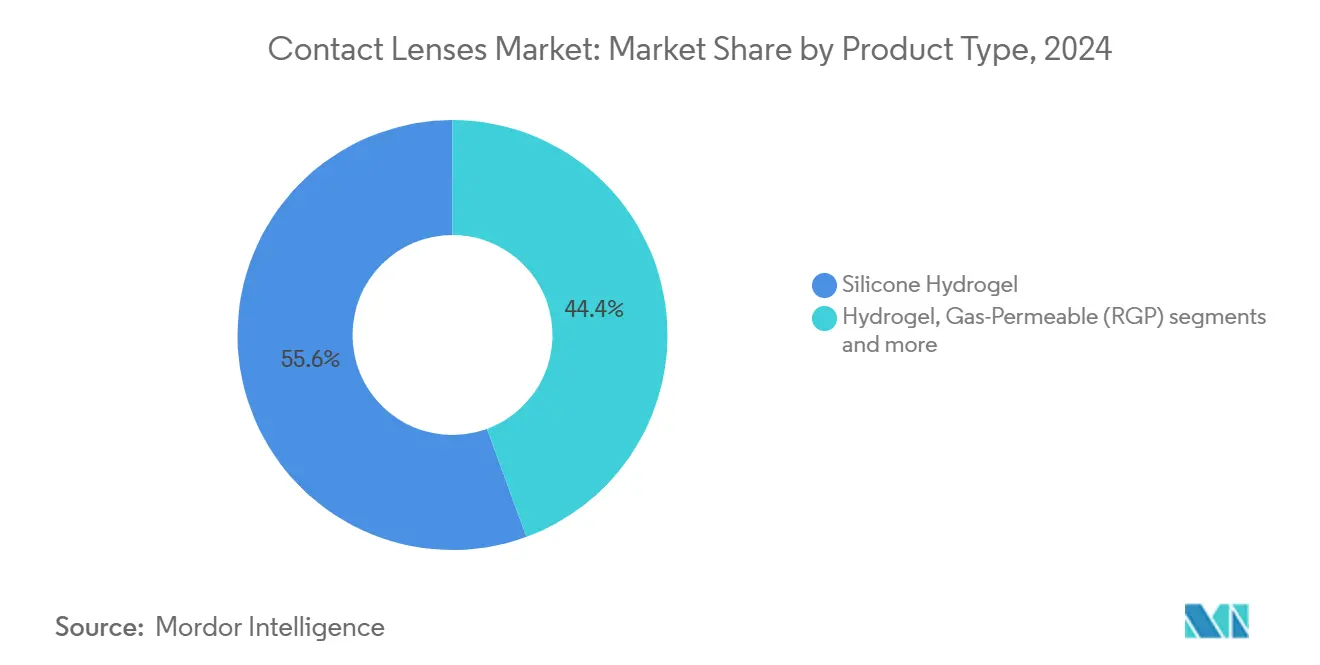
Note: Segment shares of all individual segments available upon report purchase
By Design: Spherical Lenses Lead Amid Toric Acceleration
Spherical products retained 42.34% of the contact lenses market share of 2024 sales, buoyed by straightforward fits for myopia and hyperopia. Toric lenses, however, will post the segment’s strongest 4.67% CAGR as diagnostics identify latent astigmatism and stabilizing geometries improve rotational consistency. Multifocal formats aim at presbyopic boomers but still encounter adaptation resistance.
Advanced lathe-cutting and wavefront-guided molds now deliver bespoke optics, reducing higher-order aberrations and nurturing loyalty. Meanwhile, cosmetic overlays flourish in Asia’s social-media ecosystems. The contact lens market continues diversifying design SKUs, pressing manufacturers to automate small-batch production while maintaining price competitiveness.
By Usability: Daily Disposables Capture Convenience Premium
Daily disposables represented 48.93% revenue in 2024 and will grow fastest at a 5.01% CAGR. Unit pricing exceeds monthly lenses, but elimination of cleaning solutions plus infection-risk reduction rationalizes the spend for affluent users. The contact lens market share leadership of this modality benefits from consumer subscription models that secure predictable cash flows for sellers.
Weekly and bi-weekly formats address mid-tier budgets, yet the rise of high-oxygen daily materials may squeeze these schedules. Monthly lenses endure in emerging economies where cost per day remains decisive. Manufacturers use digitally printed packaging and QR-based reordering to cement habitual purchasing, deepening daily disposables’ moat.
By Application: Vision Correction Holds, Therapeutics Surge
Vision correction continued to supply 59.45% of turnover in 2024. However, myopia-control lenses, expanding at 5.37% CAGR, illustrate the swing toward preventive ophthalmology. Drug-eluting designs treat glaucoma, allergy, and post-surgical inflammation, with sustained delivery improving adherence. The contact lens market size for therapeutic indications is still modest but carries higher average selling prices and thicker regulatory files.
Cosmetic use aligns with fashion cycles; hence demand spikes during cultural events and social-media campaigns. Orthokeratology lenses worn overnight reshape corneal curvature, appealing to adolescents seeking daytime freedom from aids. Such specialty niches require practitioner-led fitting, embedding professional services into the product value chain.
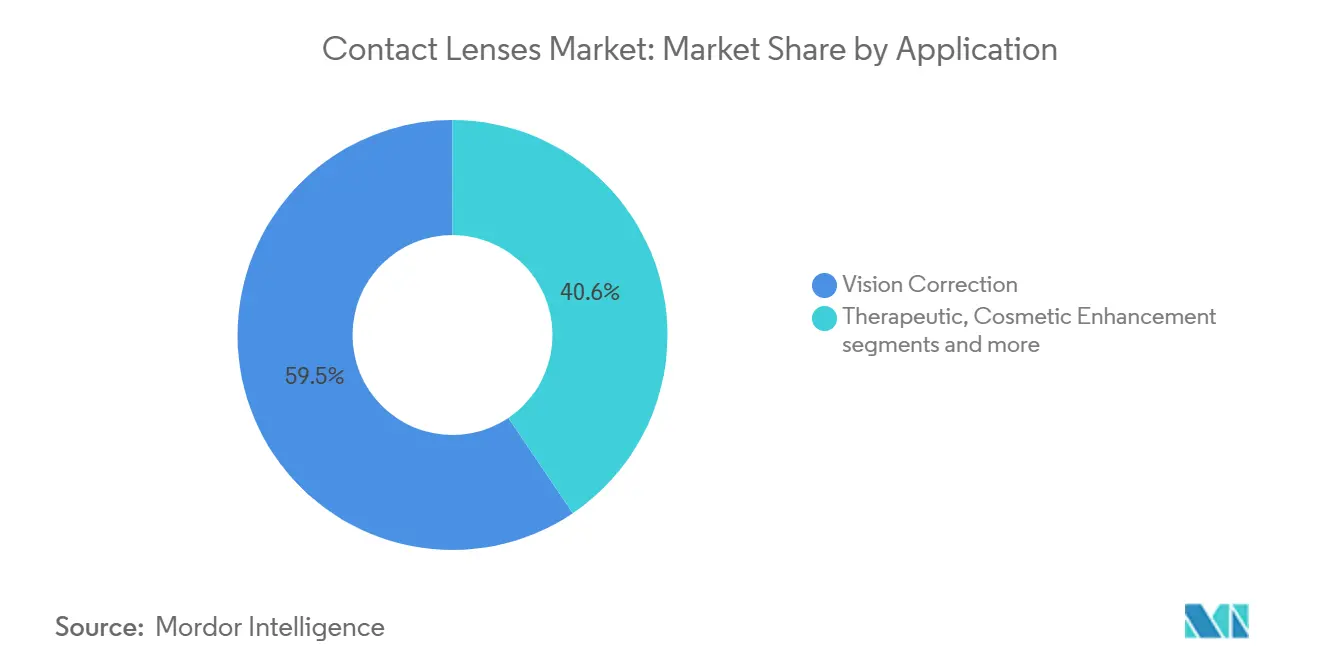
Note: Segment shares of all individual segments available upon report purchase
By Distribution Channel: Digital Transformation Challenges Retail
Optical stores maintained 46.67% of 2024 receipts because complex fits and follow-up exams need chair time. Yet online channels, expanding 5.76% annually, win replenishment orders from seasoned wearers. The contact lens market size captured by pure-play e-commerce firms is rising quickly in the United States, Japan, and parts of Europe where electronic prescription validation is streamlined.
Hospital clinics dominate therapeutic and specialty dispensing, given regulatory guardrails. Hybrid retail models surface, with practitioners offering app-based subscription refills plus in-office aftercare. Traditional chains retrofit stores into experience centers showcasing diagnostic tech, while click-and-collect counters limit shipping costs for single-day lenses.
Geography Analysis
North America remains the largest region by value, supported by insurance coverage and practitioner density. The United States contributes the bulk of turnover, buoyed by premium daily disposables and early adoption of myopia-control designs. Canada mirrors these trends at smaller scale, whereas Mexico’s youthful demographics create fresh penetration opportunities despite price constraints. Regulatory clarity under the FDA accelerates innovation, but heightened scrutiny adds cost layers that smaller entrants must navigate.
Asia-Pacific delivers the fastest growth as myopia rates soar across China, Japan, South Korea, and Singapore. China exhibits explosive e-commerce lens sales, though cross-border gray markets muddy compliance. Japan pioneers smart lens R&D, while South Korea anchors fashion-led cosmetic demand. India’s urban middle class increasingly embraces silicone-hydrogel dailies, yet broad affordability hurdles persist. Regional heterogeneity obliges tailored go-to-market tactics ranging from key-opinion-leader engagement to WeChat mini-store activations.
Europe logs steady but moderate expansion. Germany and France favor premium multifocals for presbyopia, whereas the United Kingdom’s online retailers shape price transparency post-Brexit. Sustainable packaging and PFAS-free chemistry resonate with EU Green Deal priorities, prompting lifecycle assessments across the supply chain. Southern markets like Spain and Italy lean on family-run opticians, making relationship selling crucial. Harmonized MDR requirements reinforce patient safety yet extend time-to-launch for complex therapeutics.
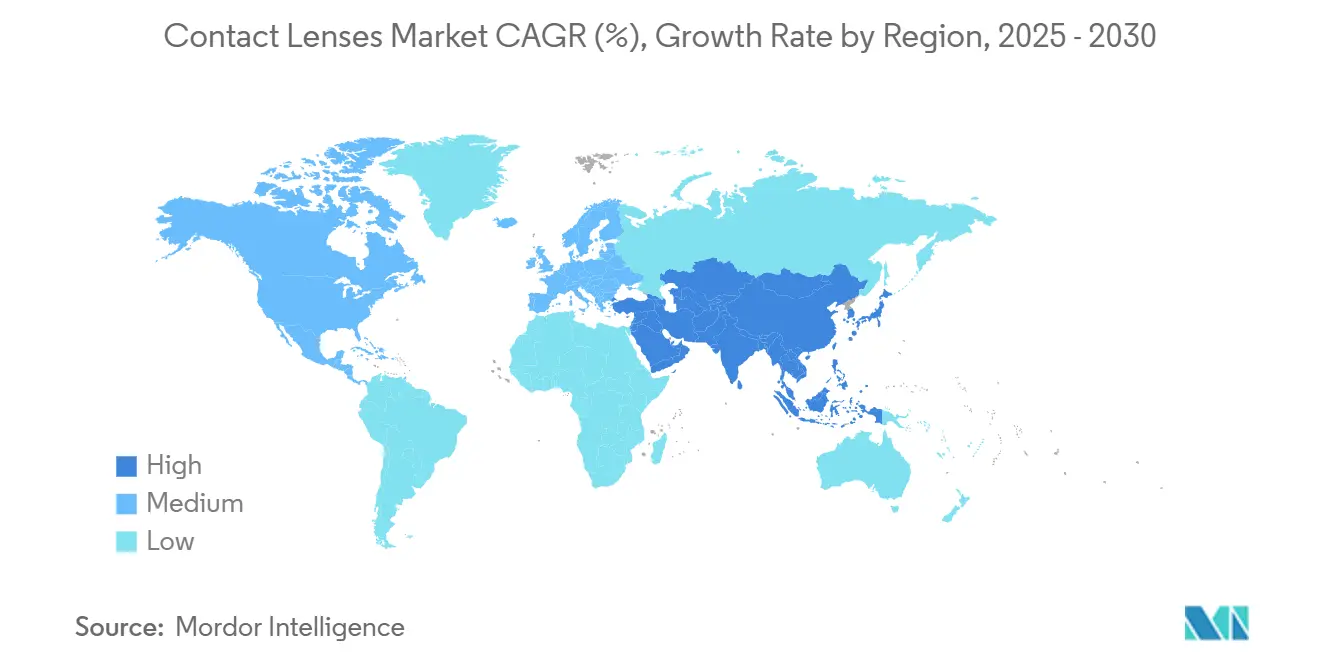
Competitive Landscape
The contact lens market tilts toward moderate concentration. Johnson & Johnson Vision Care, Alcon, CooperVision, and Bausch + Lomb collectively hold a commanding share through diversified portfolios and global logistics. These firms funnel cash into silicone-hydrogel process optimization and companion digital platforms that streamline script capture and auto-shipping. Sustainability commitments, such as CooperCompanies’ 2023 ESG roadmap, further differentiate leadership brands.
Second-tier manufacturers—Menicon, HOYA Vision Care, and specialized Asia-Pacific producers—compete via niche lenses like hyper-DK gas-permeables or vivid cosmetic series. Many license material patents or co-develop with academia to bridge R&D gaps. Consolidation persists: Alcon’s USD 81 million Belkin Vision buy fortified its glaucoma toolkit; Bausch + Lomb spent USD 106.5 million on Blink eye drops to cross-sell comfort solutions. Such deals reflect vertical integration plays that bundle lens hardware with ocular-health adjuncts.
Smart contact-lens pioneers partner with electronics and pharma giants to shoulder regulatory heft. Firmware-laden prototypes target intraocular pressure monitoring and glucose sensing but must balance miniaturized power supplies with corneal biocompatibility. Success hinges on co-creating with ophthalmologists to embed devices into routine care pathways rather than framing them as consumer gadgets.
Contact Lenses Industry Leaders
-
Essilor International SA
-
Bausch Health
-
The Cooper Companies Inc
-
Hoya Corporation
-
Alcon
- *Disclaimer: Major Players sorted in no particular order
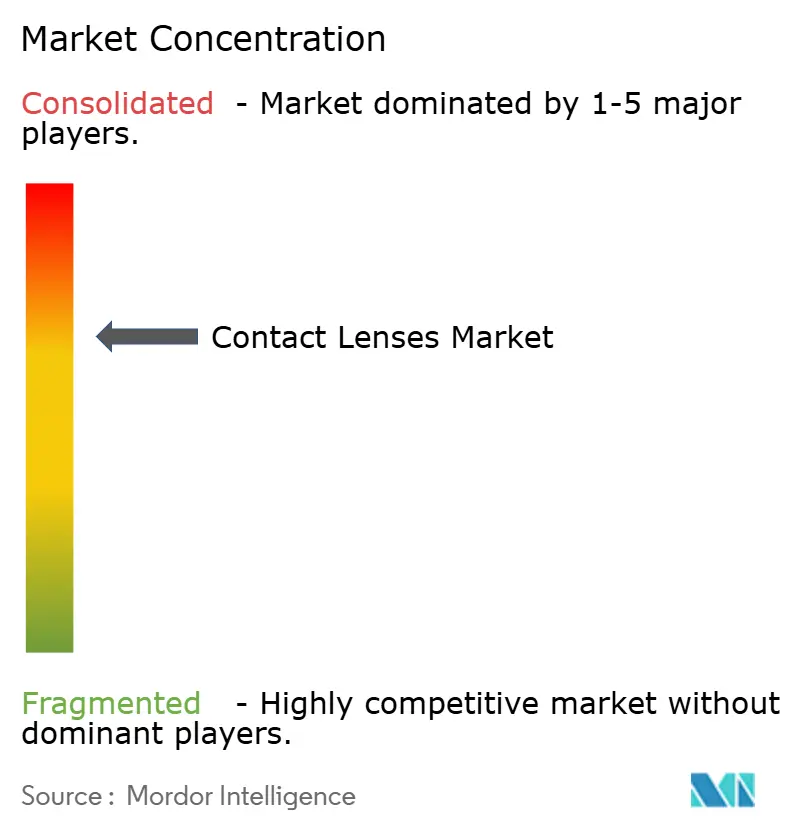
Recent Industry Developments
- April 2025: FDA cleared Bruno Vision’s FusionTechnology lens platform, unlocking a new manufacturing paradigm that could reshape silicone-hydrogel economics.
- March 2025: Bausch + Lomb acquired Blink from Johnson & Johnson Vision for USD 106.5 million, expanding its ocular-surface wellness arsenal.
- December 2024: Johnson & Johnson invested in TECLens to advance non-incisional corneal-cross-linking solutions aimed at refractive improvement
Global Contact Lenses Market Report Scope
A contact lens is a thin plastic or glass lens fitted over the eye's cornea to correct vision problems such as myopia, hyperopia, or astigmatism. Contact lenses not only serve the need to alleviate the use of hard-to-manage and bulky spectacles but also provide the added benefit of enhancing one's aesthetic appeal.
The contact lenses market is segmented by product type, usage, modality, design, and geography. By product type, the market is segmented into soft contact lenses, hybrid contact lenses, rigid gas permeable contact lenses, and other product types. By usage, the market is segmented into corrective contact lenses, therapeutic contact lenses, cosmetic contact lenses, and prosthetic contact lenses. By modality, the market is segmented into conventional and disposable. By design, the market is divided into spherical, toric, multifocal, and other designs. The report also covers the estimated market sizes and trends for 17 countries across major regions, such as North America, Europe, Asia-Pacific, Middle East and Africa, and South America. The report provides revenues and market forecasts in terms of value in USD million for the above segments.
| Silicone Hydrogel |
| Hydrogel |
| Gas-Permeable (RGP) |
| Hybrid |
| Spherical |
| Toric |
| Multifocal / Progressive |
| Cosmetic & Colored |
| Daily Disposable |
| Weekly / Bi-Weekly |
| Monthly / Quarterly |
| Extended-Wear (≥7 days) |
| Vision Correction |
| Therapeutic (Drug Delivery, Bandage) |
| Cosmetic Enhancement |
| Prosthetic / Speciality (Ortho-k, Myopia Control) |
| Retail Optical Stores |
| Hospitals & Eye Clinics |
| Online / E-commerce Platforms |
| North America | United States |
| Canada | |
| Mexico | |
| Europe | Germany |
| United Kingdom | |
| France | |
| Italy | |
| Spain | |
| Rest of Europe | |
| Asia-Pacific | China |
| India | |
| Japan | |
| South Korea | |
| Australia | |
| Rest of Asia-Pacific | |
| South America | Brazil |
| Argentina | |
| Rest of South America | |
| Middle East and Africa | GCC |
| South Africa | |
| Rest of Middle East and Africa |
| By Material | Silicone Hydrogel | |
| Hydrogel | ||
| Gas-Permeable (RGP) | ||
| Hybrid | ||
| By Design | Spherical | |
| Toric | ||
| Multifocal / Progressive | ||
| Cosmetic & Colored | ||
| By Usability / Replacement Modality | Daily Disposable | |
| Weekly / Bi-Weekly | ||
| Monthly / Quarterly | ||
| Extended-Wear (≥7 days) | ||
| By Application | Vision Correction | |
| Therapeutic (Drug Delivery, Bandage) | ||
| Cosmetic Enhancement | ||
| Prosthetic / Speciality (Ortho-k, Myopia Control) | ||
| By Distribution Channel | Retail Optical Stores | |
| Hospitals & Eye Clinics | ||
| Online / E-commerce Platforms | ||
| Geography | North America | United States |
| Canada | ||
| Mexico | ||
| Europe | Germany | |
| United Kingdom | ||
| France | ||
| Italy | ||
| Spain | ||
| Rest of Europe | ||
| Asia-Pacific | China | |
| India | ||
| Japan | ||
| South Korea | ||
| Australia | ||
| Rest of Asia-Pacific | ||
| South America | Brazil | |
| Argentina | ||
| Rest of South America | ||
| Middle East and Africa | GCC | |
| South Africa | ||
| Rest of Middle East and Africa | ||
Key Questions Answered in the Report
What is the current size of the contact lens market?
The contact lens market size stands at USD 10.60 billion in 2025 and is projected to reach USD 12.69 billion by 2030.
Which material dominates global sales?
Silicone-hydrogel lenses lead the market with 55.59% revenue share because their high oxygen permeability reduces hypoxia-related complications.
Why are daily disposable lenses growing so quickly?
Consumers favor the convenience and hygiene benefits of single-use products, pushing daily disposables to a 5.01% CAGR between 2025 and 2030.
How is myopia prevalence influencing demand?
Rising childhood myopia, especially in Asia, ensures steady demand for corrective and myopia-control lenses, contributing an estimated +1.8% to forecast CAGR.
What role does e-commerce play in lens distribution?
Online and D2C channels are expanding at a 5.76% CAGR as script verification systems mature and subscription deliveries simplify replenishment for habitual wearers.
Page last updated on:
